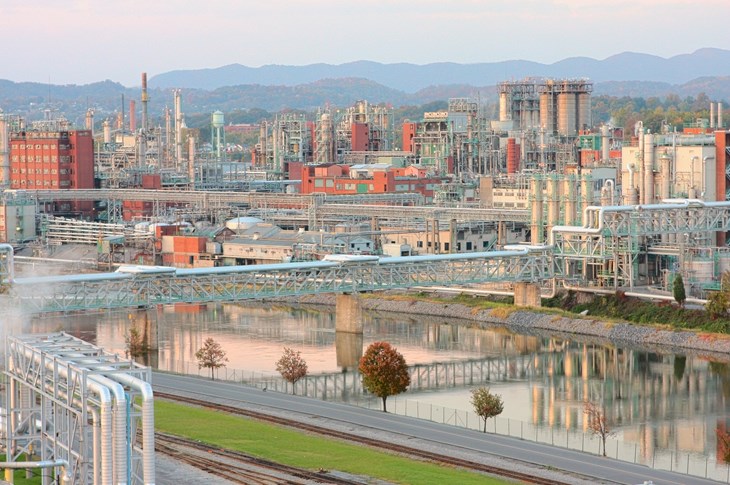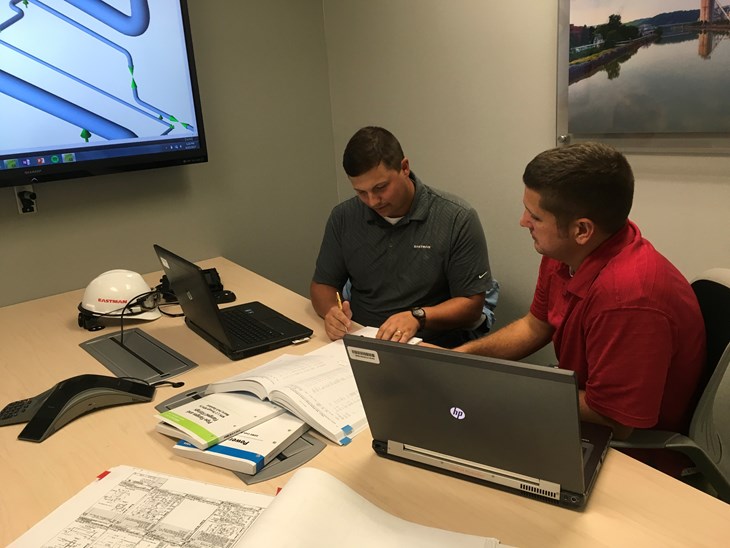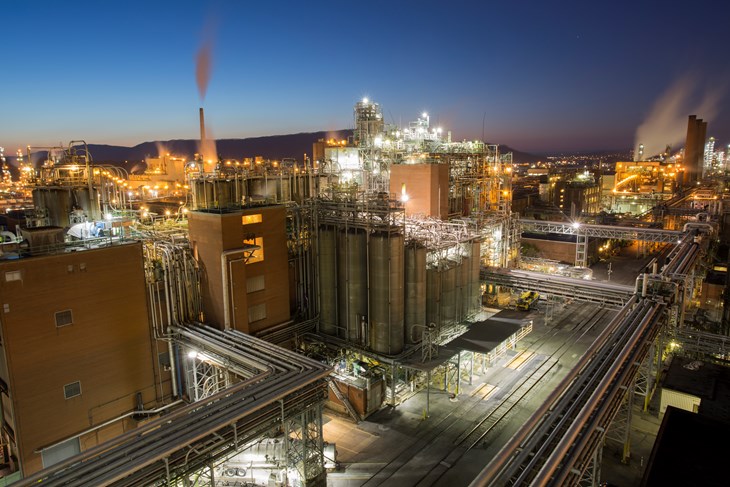Mechanical Engineer Stephen Henson always knew that he would end up working in a chemical plant. Straight out of college, Henson started at Eastman in the plant engineering division and was soon doing over sixty projects a year with budgets of up to several hundred thousand dollars. After less than two years, he reached out to Piping Engineer Patrick Wasserman to grow his expertise in the piping discipline.
For Henson, “there is no better place than Eastman to get your feet wet as an engineer,” and you can see why. Six months after reaching out to Wasserman he was on the piping team. Specializing in piping design and stress analysis, he is now a mentor to the group’s increasing number of co-op students.
Patrick Wasserman dabbled in a few mechanical process industries before finding his niche in piping. As an on-site expert specializing in all things pipe related, Wasserman quickly earned a reputation as the man to go to with the particularly complex issues, even from the other side of the world. From just a photograph, he has been able to resolve complex piping issues in Eastman facilities across the United States, Asia, and Europe.
Of course, being an expert is not without its challenges; Valve World Americas was thrilled to have the opportunity to speak to these two young professionals about the best parts of the job, the challenges they face, the tools that make it possible and how they bring out each other’s personal best through collaboration, coaching and sharing.
A Not-so-Typical Day
It is hard to say what constitutes a “typical day” for anyone on the Piping Technology team in Kingsport, not least of all because they serve the company’s global piping needs. They are responsible for all things “pipes”, from choosing the best valves and fittings for a myriad of applications to dealing with pipe stress analysis . When the piping team is called in, it is to take care of problems outside of the realm of standard engineering: the more difficult applications, one-offs and specialties.
If everything goes as planned, they might spend a day working on pipe design, performing pipe stress and flexibility analysis, writing codes and standards and providing expert support and guidance to the plant’s many engineers and support operators. However, it only takes one phone call to unsettle a carefully planned day, week, month… or even year. As on-site experts, it is up to piping engineers like Henson and Wasserman to determine the who, what, when, where and why when something isn’t working properly at the complex and to do so at lightning speed.
“We chase problems,” Wasserman tells [Valve World Americas]. “It might be a problem that is time-dependent or there is a risk that somebody could lose money on a product, so we have to get on it. We try to get the best information we can and then we chase it until it is done. Everything else goes on the backburner.”
At Kingsport, with as much pipe underground as above ground, the sheer number and types of valves required to keep things running smoothly is staggering. Ball, plug, gate, globe, check and butterfly valves, the team has seen most of what the industry has to offer. The largest valves on site can be even fifty or sixty inches in diameter. “No one area [of the site] is the same,” says Henson. “Some areas will only want ball valves, others will only want gate. It is a plethora.”
With the variety of valves in the complex, there are always new challenges to tackle. Not all valves are created equal; not all will hold up against stress corrosion cracking or microbial-induced corrosion. The piping team continuously revisits the valves’ metallurgy, the properties of the metal, the types of valves and what applications they are being used for. The team works collaboratively with other site experts, operations and metallurgists to fill a spec for a valve that will do the job. No one situation is the same so neither is the solution.

They Love a Challenge – Engineering in a Legacy Plant
The breadth of knowledge required to be able to respond to potential breaches in a manufacturing plant is formidable. In a multi-generational plant, it can be downright intimidating. Challenges as simple as limited floor space can make installing an engineered part impossible.
“Our buildings are numbered sequentially,” explains Henson. “I am working in Building 10 right now and it is older than my dad. It is tight – when the piping is over 500 degrees with only inches of clearance on either side, the project can be very difficult. I enjoy the challenge, but it can be very frustrating at the same time. All I want to do is put in the best design, but implementation is not always straight forward.”
As with many plants built over the course of decades, the team is also dealing with a lot of timeworn parts; pieces that are no longer available or no longer being manufactured. “We might come across a gasket that has been in a heat exchanger for thirty years,” says Wasserman. “There are products installed out here with the serial numbers one and two… and those are the only serial numbers that exist here or in the world!”
To eliminate the costly problem of obsolescence, the team has access to an in-house digital reproduction group to recreate and rebuild these one-offs. With the FaroArm, a portable coordinate measuring machine (CMM), they can perform a dimensional analysis on the part, see what it looked like, what size it was and get its geometry. Once they have that information, technicians reverse engineer the part and create a solid model using SolidWorks, a computer-aided design (CAD) and computer-aided engineering (CAE) program. Now that they have a model, they can recreate the part onsite in the metal fabricating shop (“the big shop”) and test it onsite at Eastman’s in-house certified valve shop.
“We have some great internal resources,” says Wasserman. “Eastman does an excellent job of investing and making sure that we have the right tools. A lot of people do not know that we team up with metallurgists on almost every project. We have five metallurgists on site and two metallurgical technicians for materials specifications and testing.”
Onsite metallurgists also come in very handy when the team comes up against issues such as abrasion and corrosion. In cases of corrosion, the team works with metallurgists to determine the best metal grade for the replacement part. It is important to the piping team that they understand what is in the pipes. The team, and the company, are committed to putting safety above all else but to do so they must first understand which processes and applications will need those higher metal grades. “You start with your base metals,” explains Henson. “You decide if readily available material is appropriate for the application. If the answer is no, then you work your way up.”
It will come as no surprise to anyone in the engineering world that one of the biggest challenges our experts face is dealing with change in the industry, especially in a multi-generational workforce. Many of the operators working in the Kingsport facility have been working there since graduation and some are even second or third generation Eastman. It can be tough to convince these seasoned veterans to break away from the way it has been traditionally done.
“Getting people to embrace change is a challenge,” says Wasserman. “You really have to provide the science and the logic behind making a change, otherwise it might not take. It is much easier to give up and stick with what you are comfortable with.”
For this and other reasons, the piping team at Eastman employs a simple yet effective philosophy when it comes to design: keep it simple. “The simpler the better,” says Henson. “Use standard parts, standard pieces. It is not about flexing our engineering muscles; it is about using those parts and pieces in an innovative way to make things safer and easier for the operators out in the field.”

Collaborating and Coaching for Personal Growth
Eastman, as part of its corporate philosophy, believes that people are at the heart of its success. It is not only what is achieved but how it is achieved that is the measure of true success. For this reason, they are committed to achieving results through collaboration and bringing out the personal best in their people through coaching and mentorship.
It was clear from speaking to our piping experts that this is not just empty corporate jargon. The Kingsport site runs smoothly on the principles of knowledge sharing, mentorship, continuous learning and community. This is no small feat in an industry that is beginning to experience a high number of retirees.
“I think some people see it as a threat to transfer some of the knowledge that they have earned over the years,” says Wasserman. “They want to keep their jobs, they want job security. But people do not feel threatened in our group, because we know how important it is to share knowledge, especially in a legacy plant when you really need to know the history of the place. If you can get someone to realize that you are not after their job, that you just want to help, it is not that hard.”
When Henson wanted to learn more about piping, he found a mentor in Wasserman. Even now, though they work side by side, he tells us that Wasserman continues to be someone that he can look up to and learn from. The difference is experience; by sharing the knowledge that they earn with each other, they are able to do far more. That is the beauty of the job, according to Wasserman.
“While I may be considered a company expert on certain things, I am still learning. There is still a lot that I have not seen. I share what I learn with Stephen, and what he learns he shares with me. If the day comes that I am not learning anymore, it will stop being fun.”
Luckily, on a site the size of Kingsport, that day will likely never come. We asked our piping experts what they see for the future of the industry and what role they, and Eastman, will play within it.
Innovation and Community for Long-term Success
Maintaining success in the industry, in Henson’s opinion, comes down to diversity of product offerings and investing in innovation to move forward with new products and find innovative ways to use existing products. With its hand in so many different markets and continuing to expand into new and niche markets, Eastman is making smart choices for long-term term success as a specialty materials company.
Creating communities is something the company excels at. Henson is part of the Eastman Professional Development Club (EPDC), an in-house development association comprised of everyone from new hires to vice presidents. They host programs, dinners and social events for the whole of the Eastman community and it goes a long way to attracting and retaining the best talent.
“The mentorship is about more than just engineering,” says Henson. “It is a community. I moved here from six hours away and through the [EPDC] I was able to come in and feel like I was at home from day one.”
Wasserman, a father of four, also appreciates that the company encourages work-life balance and strong ties to the community. “Nobody wants you to work one hundred hours of overtime,” he says. “They want you to have a family and a life. It is a beautiful place to raise a family and an excellent job; I would not trade it for anything in the world.”



